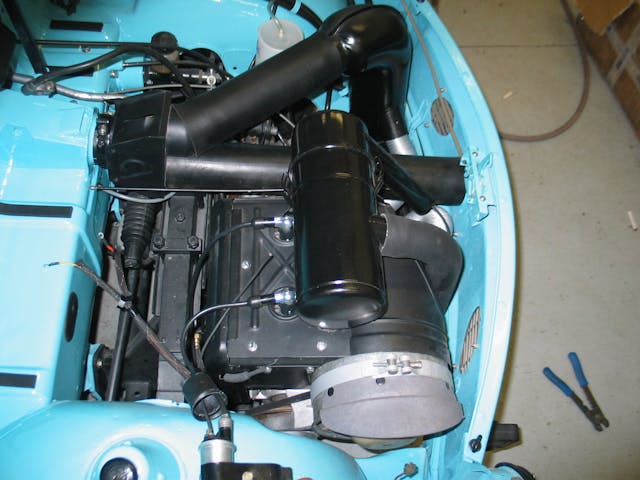A two-stroke Mazda on the way? There’s precedent for that
As has so often been the way, Mazda is apparently taking an unusual path as it seeks to keep the internal combustion engine alive. The Japanese company which succeeded where others failed with the Wankel rotary is now exploring the two-stroke engine for use in future vehicles.
If you need a quick recap, the two-stroke does have some significant advantages over the ubiquitous four-stroke engine. Combining the compression and combustion of fuel in one stroke of the piston and the intake and exhaust stroke in a second means that a complete power cycle occurs in just, well, two strokes. Effectively, the result is power twice as often as in a comparable four-stroke motor. Two-stroke engines are also much more mechanically simple, with no camshafts, poppet valves, or other moving parts in the top of the engine; this renders them lighter and cheaper to build. However, the two-stroke system has always required oil to be premixed with the injected fuel for lubrication, and that’s a no-no for emissions.
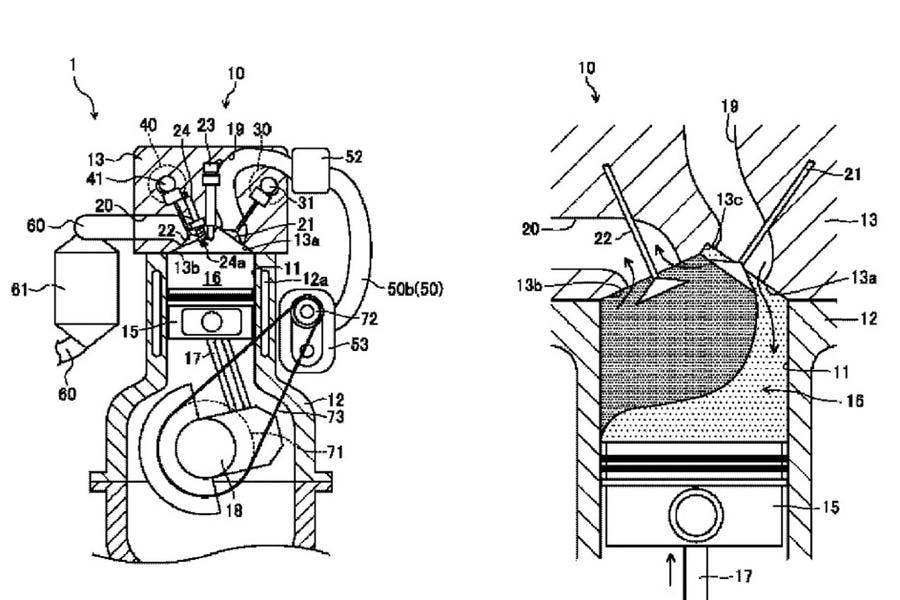
Mazda’s solution appears to be closer to a four-stroke in that it has valves in the cylinder head and oil in the sump. The clever bit? Mazda is planning to use variable valve timing and its Skyactiv-X spark-controlled compression ignition (SCCI) system for an incredibly lean burn. Direct fuel injection is used, along with a belt-driven roots-style supercharger to achieve this. At low to medium loads the engine would run in lean-burn compression ignition mode, switching to spark ignition when more power is required.
Mazda has filed a patent application for a single-cylinder version, but there’s no reason why the system wouldn’t work with multi-cylinder motors. It could potentially serve as a range-extender (just as the rotary has returned) or even as a main power unit. Of course, given the automotive industry’s rapid pivot to battery electric this Mazda motor may never see the light of day at all, and the two-stroke would be confined to history.
Whether or not Mazda succeeds in reviving the two-stroke, it does give us good reason to look back on the carmakers that previously made a go of it. Hold your breath, this could get quite smoky.
DKW

DKW was already the world’s biggest motorcycle manufacturer when, in 1928, the German firm decided to apply its two-stroke technology to four wheels. The Type P Roadster and Cabriolet packed a tiny 584 cc in-line twin offering 15 hp, and quite handsome wooden bodywork. DKW was always the innovator, switching to front-wheel drive for its F-Series, developing a starter-generator, and even experimenting with supercharging and triple-cylinder power units. The company became part of Auto Union in 1932, but after World War II its Saxony base was on the ‘other’ side of the Iron Curtain and it took until 1949 to restart production of the F-Series in West Germany. A racy two-seater Monza was briefly made in 1956, setting a host of speed records at its namesake circuit, but soon the DKW badge was replaced by Auto Union on the popular AU 1000 which by this stage was capable of producing a mighty 50 hp from a liter capacity. Even that wasn’t enough for the AU/DKW engineers who went on to develop a 100-hp V-6, but it (sadly) failed to enter production. The final DKW was built in 1964.
Trabant
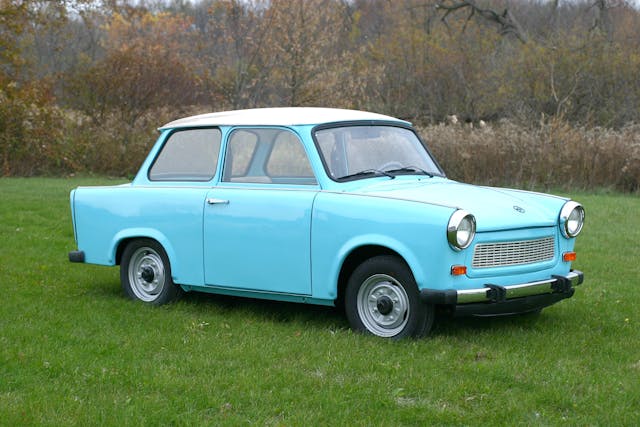
For the western world the Trabant remains a symbol of the end of the Cold War, when these tiny, essentially cardboard-bodied, East German cars flowed into West Berlin as the wall came tumbling down. Dating to 1957 and powered by an air-cooled 500 cc, two-cylinder two stroke, based on DKW’s pre-war design it was an astonishing example of just how far automotive technology lagged behind the Iron Curtain. Even the last P601 models could muster just 37 hp from their 600 cc engines and Trabant eventually gave up on the two-stroke in 1989, installing a 1.1-liter VW Polo engine instead.
Wartburg

The Trabbi didn’t have a lot of competition, but what little there was came from Wartburg. Once more it was DKW’s 1930s engineering that underpinned the Wartburg 353, albeit with a rather more generous 993 cc, three-cylinder two-stroke that sent 55 hp to the front wheels. It featured a freewheel system as part of the four-speed transmission which meant you could shift without using the clutch and, more importantly, it protected the engine from oil starvation. It was, by all accounts, a rather woeful driving experience, marginally improved 22 years after its 1966 debut with the fitment of a 1.3-liter VW engine for its final years. Nonetheless, more than a million were sold. Beggars can’t be choosers.
Berkeley
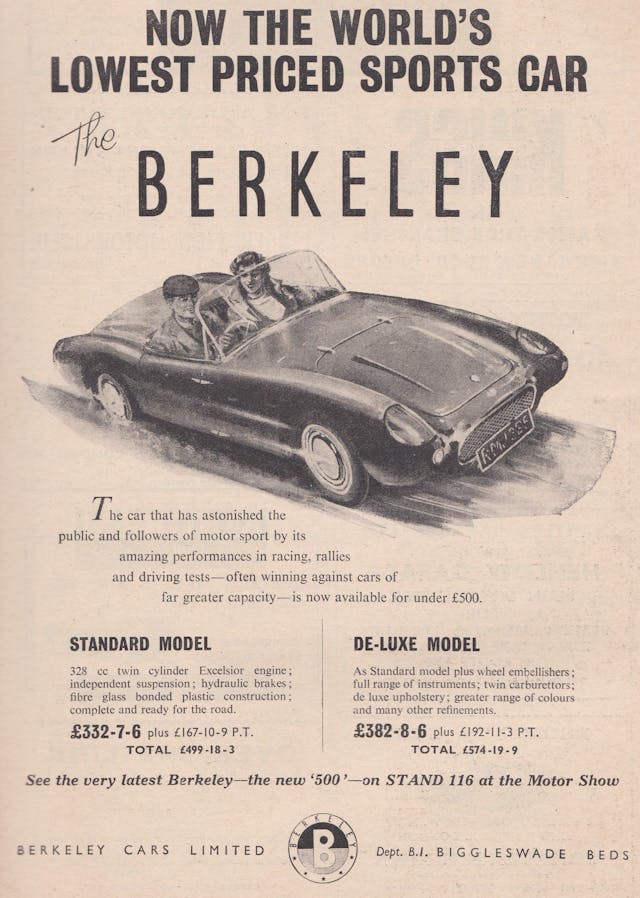
Things started well for fledgling British sports car maker Berkeley. Its Sports model with nifty MG-rivalling roadster styling and a 332 cc Anzani two-stroke motorcycle driving the front wheels, was hustled round Goodwood by no less than Stirling Moss gaining immeasurable positive PR. At just 606 pounds the car weighed next to nothing but, even so, the Anzani’s 15 hp was a little lame. Sure, the independent coil sprung suspension helped handling, but within a year double the power was offered with a triple-cylinder, triple-carb 492 cc Excelsior engine. One such model even won its class in the 1958 12 Hours of Monza. Berkeley, like all two-stroke users would ultimately admit defeat and the last iterations were fitted with a Royal Enfield four-stroke instead.
Saab
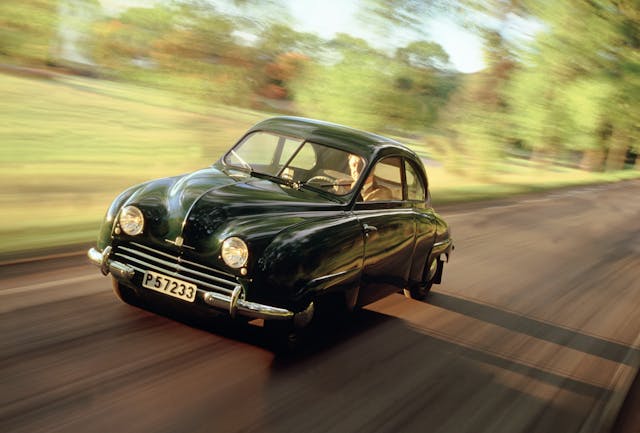
Oh Saab, how we miss you and your Swedish weirdness. Your center mounted ignition switches, your black-out dashboards and your turbocharged torque steer. It all began, of course, with a two-stroke. The scarab beetle-styled ultra-aerodynamic 92 of 1949 came with a 764-cc, 33-hp water-cooled two-cylinder two-stroke motor based on, you guessed it, an original design by DKW. Like Wartburg its three-speed transmission had a freewheel device fitted, but unlike the East German machine the Saab was packed some prowess when it came to handling. This was proven just two weeks after the car was launched when Rolf Mellde came second in his class on the snowy Swedish Rally. Saab persevered with the two-stroke, increasing its capacity and power output through the 93, 94, 95, 96 and the sportiest Sonnet and GT750. Like DKW the Swedish firm even made its own two-stroke V-6 in the 140-hp Monster prototype. After almost 20 years of two-stroke power Saab switched over to a Ford V-4 in 1967.
Suzuki
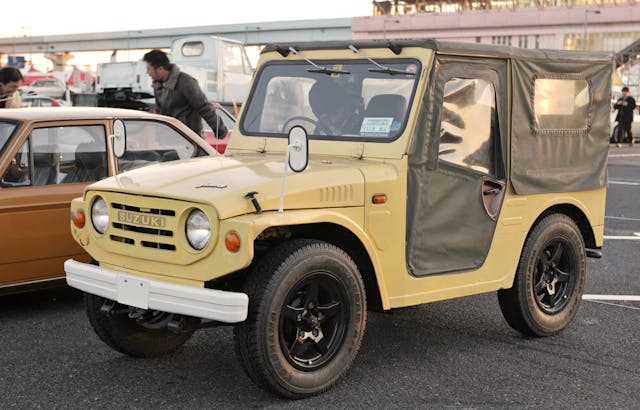
Following a path not unlike that of DKW, Suzuki’s move from two wheels to four also saw the Japanese manufacturer trialing two-strokes. Alongside Kei-class commercial vehicles the firm’s two-cylinder, air-cooled, 359-cc, 25-hp engine was fitted to its 1970 LJ10 Jimny pocket off-roader, propelling it to just 50 mph. Five years later a second generation SJ10 adopted a three-cylinder 26-hp version and stretched that top speed to 60 mph. Another two years on, however, and the two-stroke was no more.
